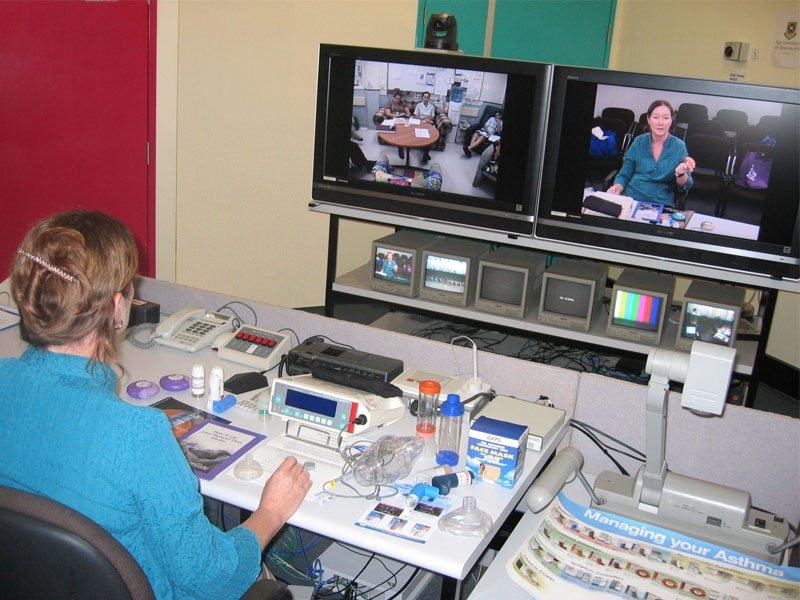Health care and how to fund it was a hot political topic last week. But only the week before NBN Co had been providing its own input, promoting telehealth with its NBN’s guide to health in the home.
The disconnection between the Prime Minister’s rhetoric and NBN Co’s ambition helps us understand why an FTTP NBN was superior, and why the terminating device had four data ports.
‘Telehealth’ is a portmanteau term that means many different things to many people. The applications that sit within the definition actually cover any case where the patient and a medical practitioner are in two different locations. So just ringing your GP to get some test results fits the definition, as would be checking an immunisation status on an e-health record.

It was thinking of these kinds of telehealth applications that prompted Malcolm Turnbull’s response as Opposition spokesman that “Many telehealth applications do not require much bandwidth at all.”
But more significantly the new applications are those designed to replace something that currently requires a visit. At the very high end these applications include ‘haptic’ devices that actually allow a skilled surgeon in one location to help guide the hand of another surgeon who is with the patient in another place.
These though are applications running between specialist clinics and don’t make the case for ubiquitous broadband.
The area of greatest interest though is in the field of video-conference supported consultations. Its greatest application isn’t in initial diagnosis, but in follow-up visits and rehabilitation programs. These are draining on the health budget both for the practitioner time involved, but also the cost of patient transport which is often borne by the health budget.
For video-conference supported consultations the critical element is the capability of the uplink, because that determines what the clinician sees. The NICTA report Australian telemedicine opportunities in the context of the National Broadband Network provided a useful summary of the bandwidth and latency requirements for clinical grade conferencing. At least 3 Mbps up is required.
Once again in Opposition Minister Turnbull dismissed telehealth ambitions by noting that at least 50 per cent of households would have no more than a 12/1 service.
Here he showed his limited understanding of the NBN and the distinction between it and a simple Internet access service.
Mr Turnbull was right, telehealth as an Over The Top service is too dependent on the quality of service quality of the ISP. That’s why the FTTP NBN model provided the option for more than one data port (four in fact). The health care provider in giving the home kit to the patient would organise an additional connection at 25/5 including 5 Mbps of committed capacity to ensure quality.
This use of the extra ports was made clear in July 2013 (though the story called it unmetered, what it meant was it wasn’t part of the end-user’s bill.) This “government revenue” was one of the items simply cut from the NBN Co financials in the construction of the Strategic Review (Page 58).
The so-called NBN Strategic Review must now be one of the most discredited documents ever produced by a Government. This is just a demonstration of how one of the arbitrary revenue write-downs (this one specific to FTTP) were incorrectly determined.
That the costs of FTTP were grossly overstated and those of MTM understated has already been well documented. The fact that NBN Co has been achieving the ARPU growth originally forecast is just another piece of evidence that the review was flawed.
But the truly disappointing part is that the move to the so-called Multi-Technology Mix has cut off the option for developing telehealth applications. No matter how much NBN Co might like to spruik them still, they simply aren’t building the right network.
But what should we have expected from Mr Turnbull. His Digital Economy and e-Government policy dismissed health and education benefits as being “State responsibilities.”
The AIIA report One In Four Lives published in 2014 concluded:
There seems to be some consensus from the findings of the mentioned Telehealth activities that a National Strategy for Telehealth should be targeted, purposeful and efficient in nature. We should use such a strategy to drive development of new business models, and/or clinical interventions, rather than passively accept those that might present serendipitously in convenient or timely circumstances.
Such a national telehealth strategy has been made all the harder by the technology choice of the Prime Minister.
But when confronted with the big policy challenge of rising health costs, the Prime Minister’s response wasn’t to look to innovation as a solution. The extent of his vision was limited to playing politics with the States; having said he wanted to move past the blame game his crowning statement after COAG was to blame the States.
Tony Abbott in his 2009 book Battlelines summarised the political reality, writing:
It’s almost an iron law of politics that voters will demand action from any level of government with a realistic prospect of making a difference. Ultimately, they will demand satisfaction from the highest level of government to which they have ready access.
Constitutional niceties don’t matter to the Australian people. They know there is a problem and they know the Commonwealth is the only one that can fix it.
In health that is going to have to start by finish building the real NBN – four ports and all! Even NBN Co is starting to understand that now.
Do you know more? Contact James Riley via Email.

